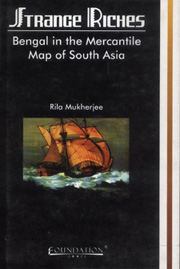Book contents
- Frontmatter
- Contents
- Epigraph
- Preface
- Acknowledgments
- Abbreviations
- Map 1 Places mentioned in Bengal and Arakan: 5th to 13th centuries
- Map 2 Land and sea routes of the Eastern Indian Ocean: 13th to 15th centuries
- 1 Introduction
- 2 Conceptual Formulations
- 3 Key Issues: Bengal
- 4 Introducing Bengal
- 5 The Debated Century
- 6 Networks and States in South Asia
- 7 Unities of Time and Space in Bengal
- 8 Bengal in the Indian Ocean Centred World Economy
- 9 Conclusion
- Bibliography
- Index
8 - Bengal in the Indian Ocean Centred World Economy
Published online by Cambridge University Press: 26 October 2011
- Frontmatter
- Contents
- Epigraph
- Preface
- Acknowledgments
- Abbreviations
- Map 1 Places mentioned in Bengal and Arakan: 5th to 13th centuries
- Map 2 Land and sea routes of the Eastern Indian Ocean: 13th to 15th centuries
- 1 Introduction
- 2 Conceptual Formulations
- 3 Key Issues: Bengal
- 4 Introducing Bengal
- 5 The Debated Century
- 6 Networks and States in South Asia
- 7 Unities of Time and Space in Bengal
- 8 Bengal in the Indian Ocean Centred World Economy
- 9 Conclusion
- Bibliography
- Index
Summary
‘Early modern history was shaped by a long since operational world economy and not just by the expansion of a European world system’ (A.G.Frank, 1998, Re Orient: Global Economy in an Asian Age, University of California Press and Sage/Vistaar: 327)
We have spoken this far of the ‘world empires’ of the Mings (1368), Ottomans (1453), the Mughals (1526) and the Safavids (1600) who participated in the politics and trade of this world. Let us now speak of ‘world economies’. World empires can exist as sub-sets within a single world economy and the world economy ultimately creates a world system with a hierarchical ordering of spatial units articulated to the structure of the state that is central to it. We saw that the Indian Ocean was a world system motored by a world economy that was constituted by the world empires that participated in its economic life.
So what denotes a world economy? It denotes, firstly, a spatial physical territory centred around an intital process of state formation and its outward projections over space and time. The two main markers of a world economy are its durability over time and its capacity to govern economic activities from its peripheries to the advantage of its core area. Secondly, a world economy, when it has retained its hegemony over surrounding regions for a long enough time, transforms itself into a world system where the dominant positions of power may not always be expressed through economic relationships.
- Type
- Chapter
- Information
- Strange RichesBengal in the Mercantile Map of South Asia, pp. 346 - 366Publisher: Foundation BooksPrint publication year: 2006



